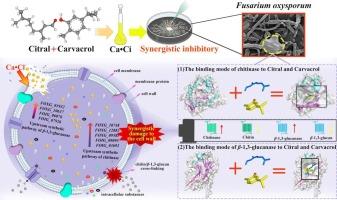Synergistic antifungal activity and mechanism of carvacrol/citral combination against fusarium oxysporum in Dendrobium officinale
IF 4
1区 农林科学
Q2 BIOCHEMISTRY & MOLECULAR BIOLOGY
引用次数: 0
Abstract
The soft rot disease caused by Fusarium oxysporum leads to a significant reduction in the yield of Dendrobium officinale. However, research into the synergistic inhibitory effect of essential oils in D. officinale is extremely limited. In this study, we systematically investigated the direct and indirect inhibitory activity of carvacrol, citral and their combination against F. oxysporum, and their synergistic inhibitory mechanism. Carvacrol and citral exhibited significant direct and indirect inhibitory activity against F. oxysporum with EC50 values of 54.37 mg/L and 119.32 mg/L (direct), 18.01 μL/(L•air) and 48.70 μL/(L•air) (indirect). Synergistic analysis revealed that the optimal synergistic toxicity of carvacrol and citral combination (Ca•Ci) against F. oxysporum was 10:1, with co-toxicity coefficient (CTC) of 131.57 and EC50 value of 44.24 mg/L. Microscopy confirmed that the Ca•Ci led to more significant tip constriction, uneven surfaces and serious rupture of F. oxysporum mycelia than single compound. Transmission electron microscopy (TEM) showed that Ca•Ci also caused significant ultrastructural alterations to F. oxysporum, manifesting as cytoplasmic disorganization and partial organellar disintegration. Moreover, Ca•Ci dramatically increased the sensitivity of F. oxysporum to calcofluor white compared with a single compound. Ca•Ci also considerably upregulated the expression of chitinase-related gene (FOXG_12882) and β-1,3-glucanase-related gene (FOXG_10637) in F. oxysporum, resulting in higher chitinase and β-1,3-glucanase activity. However, it should be noted that carvacrol exerted a greater contribution than citral. In conclusion, the combination of carvacrol and citral greatly disrupted the cell wall integrity of F. oxysporum, thereby exhibiting a synergistic effect.

香芹酚/柠檬醛复合对铁皮石斛尖孢镰刀菌的协同抑菌活性及机理研究
尖孢镰刀菌引起的软腐病导致铁皮石斛产量显著下降。然而,对中药精油的协同抑制作用的研究非常有限。在本研究中,我们系统地研究了香芹酚、柠檬醛及其组合对尖孢镰刀菌的直接和间接抑制活性,以及它们的协同抑制机制。香芹酚和柠檬醛对尖孢镰刀菌具有显著的直接和间接抑制活性,EC50分别为54.37和119.32 mg/L(直接),18.01 μL/(L•空气)和48.70 μL/(L•空气)。协同分析表明,香芹酚与柠檬醛(Ca•Ci)对尖孢镰刀菌的最佳协同毒力为10:1,共毒系数(CTC)为131.57,EC50值为44.24 mg/L。显微镜观察证实,Ca•Ci比单一化合物更能导致尖孢霉菌丝明显收缩、表面不均匀和严重断裂。透射电镜(TEM)显示,Ca•Ci对尖孢镰刀菌的超微结构也有明显的影响,表现为细胞质紊乱和部分细胞器解体。此外,与单一化合物相比,Ca•Ci显著提高了尖孢镰刀菌对钙荧光白的敏感性。Ca•Ci还显著上调了几丁质酶相关基因(FOXG_12882)和β-1,3-葡聚糖酶相关基因(FOXG_10637)的表达,导致几丁质酶和β-1,3-葡聚糖酶活性升高。然而,应该指出的是,香芹酚比柠檬醛的贡献更大。综上所述,香芹酚和柠檬醛的结合极大地破坏了尖孢镰刀菌细胞壁的完整性,从而表现出协同效应。
本文章由计算机程序翻译,如有差异,请以英文原文为准。
求助全文
约1分钟内获得全文
求助全文
来源期刊
CiteScore
7.00
自引率
8.50%
发文量
238
审稿时长
4.2 months
期刊介绍:
Pesticide Biochemistry and Physiology publishes original scientific articles pertaining to the mode of action of plant protection agents such as insecticides, fungicides, herbicides, and similar compounds, including nonlethal pest control agents, biosynthesis of pheromones, hormones, and plant resistance agents. Manuscripts may include a biochemical, physiological, or molecular study for an understanding of comparative toxicology or selective toxicity of both target and nontarget organisms. Particular interest will be given to studies on the molecular biology of pest control, toxicology, and pesticide resistance.
Research Areas Emphasized Include the Biochemistry and Physiology of:
• Comparative toxicity
• Mode of action
• Pathophysiology
• Plant growth regulators
• Resistance
• Other effects of pesticides on both parasites and hosts.

 求助内容:
求助内容: 应助结果提醒方式:
应助结果提醒方式:


